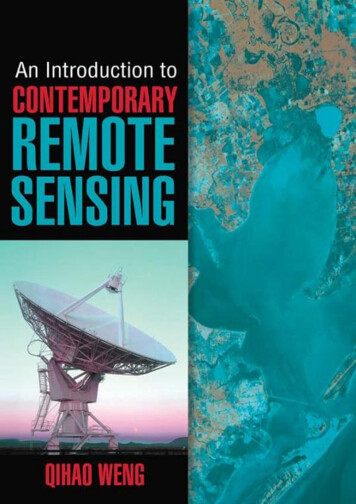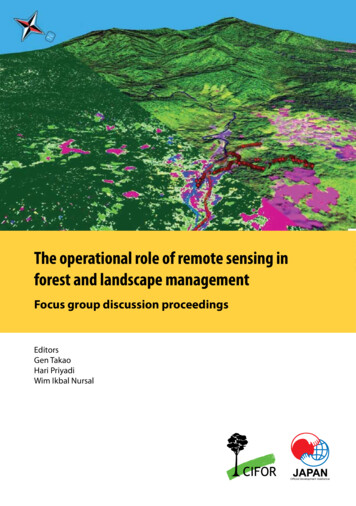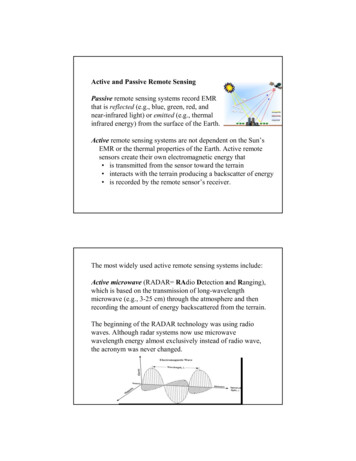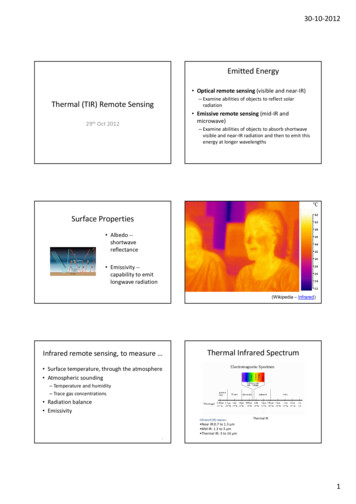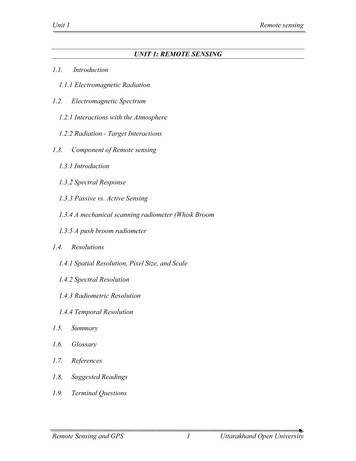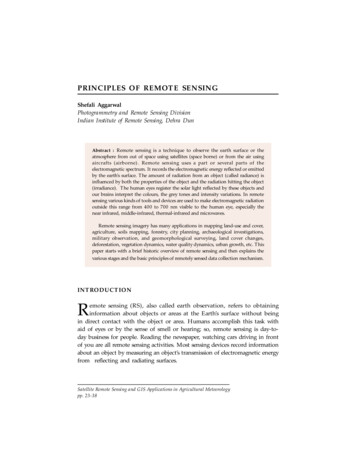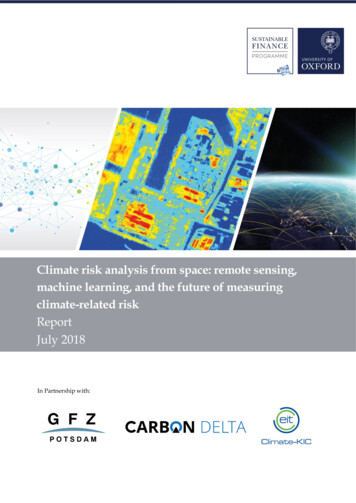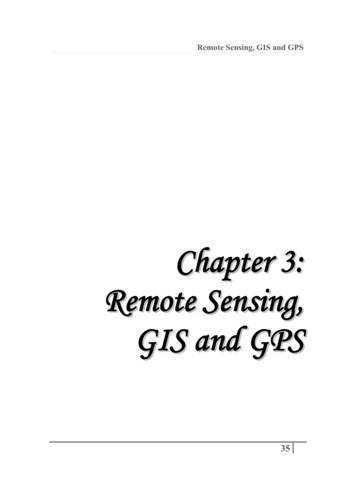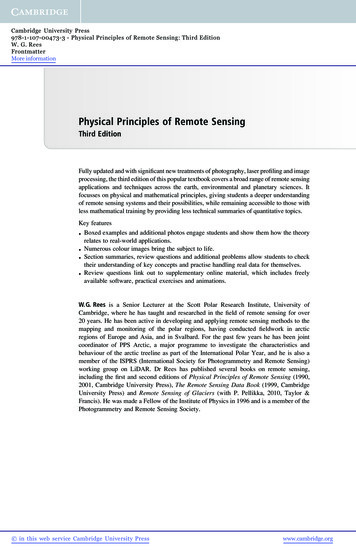
Transcription
Cambridge University Press978-1-107-00473-3 - Physical Principles of Remote Sensing: Third EditionW. G. ReesFrontmatterMore informationPhysical Principles of Remote SensingThird EditionFully updated and with significant new treatments of photography, laser profiling and imageprocessing, the third edition of this popular textbook covers a broad range of remote sensingapplications and techniques across the earth, environmental and planetary sciences. Itfocusses on physical and mathematical principles, giving students a deeper understandingof remote sensing systems and their possibilities, while remaining accessible to those withless mathematical training by providing less technical summaries of quantitative topics.Key features Boxed examples and additional photos engage students and show them how the theoryrelates to real-world applications. Numerous colour images bring the subject to life. Section summaries, review questions and additional problems allow students to checktheir understanding of key concepts and practise handling real data for themselves. Review questions link out to supplementary online material, which includes freelyavailable software, practical exercises and animations.W.G. Rees is a Senior Lecturer at the Scott Polar Research Institute, University ofCambridge, where he has taught and researched in the field of remote sensing for over20 years. He has been active in developing and applying remote sensing methods to themapping and monitoring of the polar regions, having conducted fieldwork in arcticregions of Europe and Asia, and in Svalbard. For the past few years he has been jointcoordinator of PPS Arctic, a major programme to investigate the characteristics andbehaviour of the arctic treeline as part of the International Polar Year, and he is also amember of the ISPRS (International Society for Photogrammetry and Remote Sensing)working group on LiDAR. Dr Rees has published several books on remote sensing,including the first and second editions of Physical Principles of Remote Sensing (1990,2001, Cambridge University Press), The Remote Sensing Data Book (1999, CambridgeUniversity Press) and Remote Sensing of Glaciers (with P. Pellikka, 2010, Taylor &Francis). He was made a Fellow of the Institute of Physics in 1996 and is a member of thePhotogrammetry and Remote Sensing Society. in this web service Cambridge University Presswww.cambridge.org
Cambridge University Press978-1-107-00473-3 - Physical Principles of Remote Sensing: Third EditionW. G. ReesFrontmatterMore information in this web service Cambridge University Presswww.cambridge.org
Cambridge University Press978-1-107-00473-3 - Physical Principles of Remote Sensing: Third EditionW. G. ReesFrontmatterMore information“This is a welcome new edition of a popular text, with wonderful color illustrations.The author helps students digest the principles by adding useful summaries and reviewquestions. A practical improvement for students and instructors is the addition of the richsuite of online resources, which greatly add to the book’s appeal.”Dr. Farouk El-BazDirector, Center for Remote Sensing, Boston University“Rees’ new edition of his popular remote sensing textbook is written in an easy-to-followstyle, but doesn’t neglect the mathematical underpinnings. It covers principles relatedto all the key wavelength regions, and such diverse topics as photogrammetry,atmospheric sounding and multispectral imaging. Including coverage of applications onland, in the atmosphere and oceans, it represents an excellent resource for students andpractitioners alike.”Professor Martin WoosterEnvironmental Monitoring & Modelling Research Group, Kings College London“The third edition of this well known, highly respected and authoritative textbookcontains a wealth of new material that captures advances in optical and microwave sensorsystems and applications. University teachers will be delighted that the format remainsthe same; theory and technical detail are explained in clear language and supported byexcellent diagrams and figures. The book incorporates good pedagogic principles thatincorporate summaries for each topic, additional text boxes to help guide students notfamiliar with certain theoretical concepts, and review questions with problems toassist teachers to set extension exercises. The book uses excellent examples, many ofwhich are new in this edition, that clearly demonstrate why remote sensing data froma very wide range of sensors and platforms has such an impact on science and societytoday. Every student of remote sensing, whatever their level, and every library shouldhave a copy of this excellent book.”Professor Daniel DonoghueDepartment of Geography, Durham University in this web service Cambridge University Presswww.cambridge.org
Cambridge University Press978-1-107-00473-3 - Physical Principles of Remote Sensing: Third EditionW. G. ReesFrontmatterMore information in this web service Cambridge University Presswww.cambridge.org
Cambridge University Press978-1-107-00473-3 - Physical Principles of Remote Sensing: Third EditionW. G. ReesFrontmatterMore informationPhysical Principles ofRemote SensingTHIRD EDITIONW. G. REESScott Polar Research InstituteUniversity of Cambridge in this web service Cambridge University Presswww.cambridge.org
Cambridge University Press978-1-107-00473-3 - Physical Principles of Remote Sensing: Third EditionW. G. ReesFrontmatterMore informationUniversity Printing House, Cambridge CB2 8BS, United KingdomCambridge University Press is part of the University of Cambridge.It furthers the University’s mission by disseminating knowledge in the pursuit ofeducation, learning and research at the highest international levels of excellence.www.cambridge.orgInformation on this title: www.cambridge.org/9781107004733 W. G. Rees 2013This publication is in copyright. Subject to statutory exceptionand to the provisions of relevant collective licensing agreements,no reproduction of any part may take place withoutthe written permission of Cambridge University Press.First published 20133rd printing 2015Printed in the United Kingdom by TJ International Ltd, Padstow, Cornwall.A catalogue record for this publication is available from the British LibraryLibrary of Congress Cataloguing-in-Publication dataRees, W. G. 1959–Physical principles of remote sensing / W. G. Rees. – 3rd ed.p. cm.ISBN 978-1-107-00473-3 (Hardback) – ISBN 978-0-521-18116-7 (Paperback)1. Remote sensing. I. Title.G70.4.R44 2013621.360 78–dc23 2012018197ISBN 978-1-107-00473-3 HardbackISBN 978-0-521-18116-7 PaperbackAdditional resources for this publication at www.cambridge.org/reesCambridge University Press has no responsibility for the persistence oraccuracy of URLs for external or third-party internet websites referred toin this publication, and does not guarantee that any content on suchwebsites is, or will remain, accurate or appropriate. in this web service Cambridge University Presswww.cambridge.org
Cambridge University Press978-1-107-00473-3 - Physical Principles of Remote Sensing: Third EditionW. G. ReesFrontmatterMore informationFor Christineas always in this web service Cambridge University Presswww.cambridge.org
Cambridge University Press978-1-107-00473-3 - Physical Principles of Remote Sensing: Third EditionW. G. ReesFrontmatterMore information in this web service Cambridge University Presswww.cambridge.org
Cambridge University Press978-1-107-00473-3 - Physical Principles of Remote Sensing: Third EditionW. G. ReesFrontmatterMore informationCONTENTSPrefaceAcknowledgements1 Introduction1.11.21.31.4A short history of remote sensingApplications of remote sensingA systems view of remote sensingFurther reading, and how to obtain data2 Electromagnetic waves in free space2.12.22.32.42.52.6Electromagnetic wavesPolarisationSpectra and the Fourier transformThe Doppler effectDescribing angular distributions of radiationThermal radiation2.6.1 Characteristics of solar radiation2.7 DiffractionReview questionsProblems3 Interaction of electromagnetic radiation with matter3.13.23.33.43.5Propagation through homogeneous materials3.1.1 Complex dielectric constants: absorption3.1.2 Dielectric constants and refractive indices of real materials3.1.3 DispersionPlane boundariesScattering from rough surfaces3.3.1 Description of surface scattering3.3.2 Simple models of surface scattering3.3.3 The Rayleigh roughness criterion3.3.4 Models for microwave backscatterAbsorption and scattering by particles3.4.1 Very small particles3.4.2 Larger particles3.4.3 Absorption and scattering by atoms and moleculesThe radiative transfer equation3.5.1 Propagation through an absorbing medium3.5.2 Propagation through an absorbing and emitting medium in this web service Cambridge University Presspage 59626473747678848586www.cambridge.org
Cambridge University Press978-1-107-00473-3 - Physical Principles of Remote Sensing: Third EditionW. G. ReesFrontmatterMore informationxContents3.5.3 A simple model of scattering and absorption: the two-streamapproximation3.5.4 Scattering, absorption and emission3.6 Interaction of electromagnetic radiation with real materials3.6.1 Visible and near-infrared region3.6.2 Emissivities in the thermal infrared region3.6.3 Emissivities in the microwave region3.6.4 Effect of clouds and snow on microwave radiation3.6.5 Microwave backscattering coefficients3.6.6 Modelling microwave backscattering: case study of a snowpackReview questionsProblems89939495991001021031051071084 Interaction of electromagnetic radiation with the .1 Composition and structure of the gaseous atmosphere4.2 Molecular absorption and scattering in the atmosphere4.3 Particles in the atmosphere: aerosols4.4 Fog and cloud4.5 Rain and snow4.6 The ionosphere4.7 Atmospheric turbulenceReview questionsProblems5 Photographic systems5.1Photographic film5.1.1 Performance of photographic film: speed, contrast and spatial resolution5.1.2 Digital photography5.2 Photographic optics5.2.1 Lens distortion5.3 Photogrammetry and stereogrammetry5.3.1 Relief displacement5.3.2 Stereophotography5.4 Atmospheric propagation5.5 Some instruments5.6 Applications of aerial and space photographyReview questionsProblems6 Electro-optical systems6.1Visible and near-infrared imaging systems6.1.1 Detectors6.1.2 Imaging6.1.3 Spatial resolution in this web service Cambridge University 164164167170www.cambridge.org
Cambridge University Press978-1-107-00473-3 - Physical Principles of Remote Sensing: Third EditionW. G. ReesFrontmatterMore informationxiContents6.1.4 Spectral resolution6.1.5 Atmospheric propagation and correction6.2 Types of VNIR imager6.2.1 Very high resolution imagers6.2.2 High resolution imagers6.2.3 Medium resolution imagers6.2.4 Low resolution imagers6.2.5 Ocean colour imagers6.2.6 Hyperspectral imagers6.2.7 Geostationary imagers6.3 Major applications of VNIR images6.4 Thermal infrared imagers6.4.1 Detectors6.4.2 Thermal infrared imaging6.4.3 Spatial resolution6.4.4 Spectral resolution and sensitivity6.4.5 Atmospheric propagation and correction6.5 Types of TIR imager6.5.1 High resolution TIR imagers6.5.2 Medium resolution TIR imagers6.5.3 Geostationary TIR imagers6.6 Major applications of thermal infrared images6.6.1 Earth surface temperature6.6.2 Thermal inertia6.6.3 Cloud detection and monitoring6.7 Atmospheric sounding6.7.1 Temperature profiling from observations at nadir6.7.2 Profiling of gas concentrations at nadir6.7.3 Backscatter observations at nadir6.7.4 Limb-sounding observations6.7.5 Spectral resolution for atmospheric sounding observations6.8 Some profiling instrumentsReview questionsProblems7 Passive microwave systems7.17.27.37.4Antenna theory7.1.1 Angular response and spatial resolution7.1.2 Sensitivity7.1.3 Scanning radiometersApplications of passive microwave radiometry7.2.1 Oceanographic applications7.2.2 Land surface applicationsAtmospheric correction of passive microwave imageryExamples: the SSMIS and the MSMR in this web service Cambridge University .org
Cambridge University Press978-1-107-00473-3 - Physical Principles of Remote Sensing: Third EditionW. G. ReesFrontmatterMore informationxiiContents7.5 Atmospheric sounding using passive microwave observationsReview questionsProblems8 Ranging systems8.1Laser profiling8.1.1 Scanning laser profilers8.1.2 Waveform-resolving laser profiling8.1.3 Atmospheric correction of laser profiler data8.1.4 Applications of laser profiling8.2 Radar altimetry8.2.1 Simple model of the waveform8.2.2 Effect of the Earth’s curvature8.2.3 Effect of coherence: range accuracy8.2.4 Response from a rough surface8.2.5 Applications of radar altimetry8.2.6 Atmospheric and ionospheric correction of radar altimeter data8.2.7 Example: the Envisat RA-2 radar altimeter8.3 Other ranging systemsReview questionsProblems9 Scattering systems9.19.29.3LiDARThe radar equationMicrowave scatterometry9.3.1 Applications of microwave scatterometry9.3.2 Example: ASCAT9.4 Real-aperture imaging radar9.4.1 Image distortions9.4.2 Instruments and applications9.5 Synthetic aperture radar9.5.1 More exact treatment of the azimuth resolution9.5.2 Speckle9.5.3 Distortions of SAR images9.5.4 Limitations imposed by ambiguity9.5.5 SAR interferometry9.5.6 Major applications of radar imaging9.5.7 Example: Radarsat-2Review questionsProblems10 Platforms for remote sensing10.110.2AircraftSatellites in this web service Cambridge University 1304306307312314316317318318320www.cambridge.org
Cambridge University Press978-1-107-00473-3 - Physical Principles of Remote Sensing: Third EditionW. G. ReesFrontmatterMore informationxiiiContents10.2.1 Launch of satellites10.3. Description of the satellite orbit10.3.1 Effects of the Earth’s asphericity10.3.2 Special orbits10.4 Satellite station-keeping and orbital manoeuvresReview questionsProblems11 Data processing11.111.2Transmission and storage of dataImage processing11.2.1 Preprocessing11.2.2 Image enhancement11.2.3 Band transformations11.3 Image classification11.3.1 Density slicing and pseudocolour display11.3.2 Multispectral classification11.3.3 Hyperspectral classification11.3.4 Advanced classification methods11.3.5 Sub-pixel classification11.3.6 Texture classification11.3.7 Error matrices and classification accuracy11.4 Image segmentation and detection of geometrical features11.4.1 Segmentation11.4.2 Detecting shapes11.5 Geographic information systems11.6 Image formats and data compression11.6.1 Image compression11.6.2 Image formats for remote sensingReview questionsProblemsAppendix: Data tablesA.1A.2A.3A.4A.5Physical constantsUnitsIlluminance at the Earth’s surfaceProperties of the Sun and EarthPosition of the SunReferencesIndexSee colour plates section between pages 206 and 207. in this web service Cambridge University 2412413414414417426www.cambridge.org
Cambridge University Press978-1-107-00473-3 - Physical Principles of Remote Sensing: Third EditionW. G. ReesFrontmatterMore information in this web service Cambridge University Presswww.cambridge.org
Cambridge University Press978-1-107-00473-3 - Physical Principles of Remote Sensing: Third EditionW. G. ReesFrontmatterMore informationPREFACEThere are many books that explain the subject of remote sensing to those whose backgrounds are primarily in the environmental sciences. This is an entirely reasonable fact,since they continue to be the main users of remotely sensed data. However, as the subjectgrows in importance, the need for a significant number of people to understand not onlywhat remote sensing systems do, but how they work, will grow with it. This was alreadyhappening in 1990, when the first edition of Physical Principles of Remote Sensingappeared, and since then increasing numbers of physical scientists, engineers and mathematicians have moved into the field of environmental remote sensing. It is mainly forsuch readers that this book, like its previous editions, has been written. That is to say, thereader for whom I have imagined myself to be writing is educated to a reasonablestandard (although not necessarily to first degree level) in physics, with a commensuratemathematical background. I have however found it impossible to be strictly consistentabout this, because of the wide range of disciplines within and beyond physics from whichthe material has been drawn, and I trust that readers will be understanding when they findthe treatment either too simple or over their heads.This book attempts to follow a logical progression, more or less following the flow ofinformation from the remotely sensed object to the user of the data. The first four chapterslay the general foundations. Chapter 1 sets the subject in context. Chapter 2 is a nonrigorous treatment of electromagnetic wave propagation in free space, which can beregarded as a compendium of necessary results. It will represent, I hope, mostly revisionto most readers, although it assumes little or no previous knowledge of Fourier transformsor of Fraunhofer diffraction theory. Chapter 3 discusses the interaction of electromagneticradiation with smooth and rough surfaces and with inhomogeneous materials such as soiland snow, and Chapter 4 discusses the interaction of radiation with the atmosphere andionosphere. By this stage of the book, our information is, as it were, travelling upwardstowards the sensor. Chapters 5 to 9 discuss the sensors themselves, beginning with themore familiar passive sensors and going on to consider active systems. These chaptersexplain, so far as is consistent with the level of the book, the functioning of the sensors,important operational constraints, and some of the more important applications derivedfrom them. These chapters also include brief descriptions of real instruments on existingor forthcoming satellite missions. The platforms on which the sensors are supported arediscussed in Chapter 10. After a short discussion of remote sensing from aircraft, thechapter devotes itself to satellite orbits. Finally, Chapter 11 presents an introduction to thedata processing aspects of remote sensing, particularly digital image processing andanalysis. An appendix contains tables of data frequently needed in remote sensing.A short list of problems or exercises is included at the end of most chapters. Most ofthese problems are reasonably straightforward (I have tried to indicate which arefor ‘enthusiasts’), designed to extend and consolidate the reader’s understanding ofthe material. Some problems will require material from more than one chapter for in this web service Cambridge University Presswww.cambridge.org
Cambridge University Press978-1-107-00473-3 - Physical Principles of Remote Sensing: Third EditionW. G. ReesFrontmatterMore informationxviPrefacetheir solution. The problems are of a more or less ‘academic’ format, many of themhaving originated as exercises for students.It will perhaps be useful to indicate those features of the book that have been preservedfrom the second edition and those that are new. The underlying rationale has not changed.It has still been my intention to keep the book as short as possible, consistent with clarity,although this edition is significantly longer than the second because it includes newmaterial. In particular, the treatment of stereophotography (Chapter 5), laser profiling(Chapter 8), synthetic aperture radar interferometry (Chapter 9), and digital imageprocessing (Chapter 11) have all been significantly expanded. As before, the aim hasbeen to teach principles of remote sensing rather than to present a lot of technical orengineering detail. However, the inclusion of brief discussions of real sensor systems orsurveys of types of sensor, introduced in the second edition, has been continued, expandedand updated, particularly in Chapter 6, which deals with visible-wavelength and infraredsystems. The book’s bibliography has been brought up to date, although I have stillattempted to keep it short enough so as not to overwhelm the reader with an enormous listof references. Some selection and omission has therefore been necessary, and I hope mycolleagues will forgive me if my selection does not tally with theirs. One particular goal incompiling the bibliography has been to include enough recent references to allow thereader efficiently to find his or her way into the modern literature. As in the first edition,I have deliberately avoided the rigorous consistency in the use of symbols that demandsthat a given symbol be used to represent only a single physical quantity. Because of thewide scope of remote sensing, this would lead to an unforgivably confusing proliferationof symbols with many sub- and superscripts. Consistency of symbols is therefore confinedto sections of the text that deal with a single topic, except for a few ‘universal’ symbolssuch as h for the Planck constant and o for angular frequency, which are used throughoutthe book. SI units are used consistently, although a table in the appendix gives equivalentsfor some common non-SI units.There are some other important changes in this edition. The number of illustrations hasincreased by about a third, with much greater use of colour. This is especially valuable inthe understanding of satellite imagery. As aids to understanding the ideas presented in thebook, each chapter apart from the introductory Chapter 1 now includes more or less nontechnical summaries and a set of review questions. The summaries, which are presented inboxes at the end of each major section, can be read consecutively as a 12 000 word outlineof the whole book, but are probably most usefully read where they have been placed, atthe end of each section, where they can be used to check the reader’s understanding of themain points without getting lost in mathematical detail. The review questions can also beused as an aid to comprehension of the material: when teaching university courses basedon some of this material I have found it helpful to ask students to prepare five-minuteresponses to such review questions, which they can then present to the class.One difficulty that I found in the first two editions of the book was that of clearlyexplaining the behaviour of some time-dependent phenomena. Examples of this includethe propagation of electromagnetic radiation, the orbit of a satellite around the Earth, andthe manner in which the pulse of radiation from a radar altimeter interacts with a roughsurface, although there are others. I have developed some computer animations toillustrate such phenomena, and these are accessible on the book’s website – anotherinnovation for this edition. They are indicated by a mouse-button icon in the margin. in this web service Cambridge University Presswww.cambridge.org
Cambridge University Press978-1-107-00473-3 - Physical Principles of Remote Sensing: Third EditionW. G. ReesFrontmatterMore informationxviiPrefaceThe website also provides hints and solutions to the problems, useful links, and a repository of computer programs that can be used to explore some of the ideas in the book. Theproblems included at the end of each chapter are supplemented, in the website, bysuggested practical exercises. Particular emphasis has been placed on exercises designedto consolidate the reader’s understanding of the main ideas in Chapter 11. It is expectedthat all of the web-based material will evolve over time.This book arose from a course of undergraduate lectures delivered first at the ScottPolar Research Institute, and later at the Cavendish Laboratory, both in the University ofCambridge. I am grateful to both departments for letting me try out my ideas. Manypeople are owed thanks for their contributions to the writing of the first edition. It isdifficult to single out individuals, but I particularly wish to thank Andrew Cliff, BernardDevereux, Michael Gorman, Christine Rees and Michael Rycroft. Subsequently I havedeveloped some of the concepts in the book for teaching to audiences with a wider rangeof background knowledge than the book’s intended readership, including undergraduatesin the Department of Geography at the University of Cambridge and at the GeographyFaculty of Moscow State University, and children as young as six years old. Much of thecredit for any improvements that I may have made to the book since the first edition lieswith the constructive criticisms of the users and reviewers of the first edition and of themany graduate and undergraduate students who I have had the pleasure of working withsince 1990, as well as with my professional colleagues. In particular, I thank Neil Arnold,Olga Tutubalina and Sophie Weeks. As always, Cambridge University Press has providedadvice and encouragement whenever it was needed. in this web service Cambridge University Presswww.cambridge.org
Cambridge University Press978-1-107-00473-3 - Physical Principles of Remote Sensing: Third EditionW. G. ReesFrontmatterMore informationACKNOWLEDGEMENTSPermission to reproduce copyright and other material from the following sources isgratefully acknowledged: Colorado University, Dundee Satellite Receiving Station(NEODAAS University of Dundee), the European Space Agency, GeoEye, InternationalSpace Company Kosmotras, the Japanese Aerospace Exploration Agency, Jim Doty Jr,the National Aeronautics and Space Administration (USA), the National Geospace Intelligence Agency (USA), the National Oceanic and Atmospheric Administration (USA), theNational Snow and Ice Data Center (USA), the Airborne Research and Survey Facility(ARSF) of the Natural Environment Research Council (UK), Nauchnyy Tsentr Operativnogo Monitoringa Zemli (Research Centre for Earth Operative Monitoring, Russia),the Royal Society, the University of Alabama in Hunstville, and the University ofCambridge. Some illustrations are derived from public-domain Internet resources.I have been particularly grateful for the fact that the United States Copyright Law ensuresthat a huge amount of material produced by NASA, NOAA and other organisations can bereproduced without infringing copyright.The text, all of the animations and many of the illustrations were prepared using freesoftware, principally OpenOffice (for text processing), Zotero (for management of references), ImageJ and MultiSpec (for image processing), QGIS (for geographic informationsystem processing), Plot and Veusz (for preparing graphs) and GNU Octave (for manytasks). in this web service Cambridge University Presswww.cambridge.org
University Press) and Remote Sensing of Glaciers (with P. Pellikka, 2010, Taylor & Francis). He was made a Fellow of the Institute of Physics in 1996 and is a member of the Photogrammetry and Remote Sensing Society. Cambridge Unive rsit y Pre ss 978-1-107-00473-3 - Physical Principles of Remote Sensing: Third Edition W. G. Rees Frontmatter
